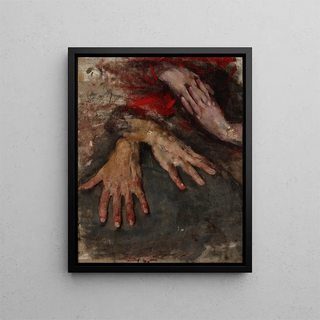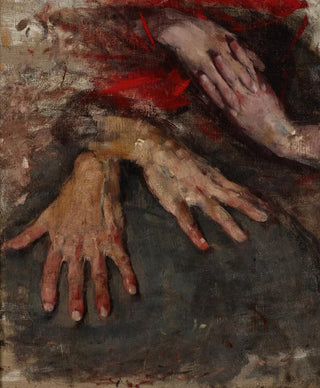Art print | Study of two pairs of hands - Olga Boznańska


View from behind

Frame (optional)
The artwork "Study of two pairs of hands" by Olga Boznańska presents itself as a captivating exploration of the human form, where the delicacy of hands becomes a visual language in its own right. In this study, the Polish artist succeeds in capturing not only the anatomy but also the emotion emanating from this everyday gesture. Hands, often considered tools of communication and expression, are transformed here into true protagonists of a silent narrative. By observing this piece, the viewer is invited to contemplate the beauty of human gestures, to feel the depth of relationships between individuals, and to question the meaning of human connection through the lens of gestural expression.
Style and uniqueness of the work
The uniqueness of "Study of two pairs of hands" lies in Boznańska's inimitable style, which blends realism and impressionism. Her precise and fluid brushstrokes add an almost tactile dimension to the depiction of the hands. Every detail, every shadow, is carefully studied to reveal the texture of the skin and the finesse of the joints. The artist skillfully plays with light, creating subtle contrasts that emphasize the volume of the hands. In doing so, she manages to breathe life into these limbs, making them almost animated. The composition, meanwhile, is balanced, with each pair of hands opposing and complementing each other, reflecting the inherent duality of human interaction. This artwork stands out for its ability to transcend the simple subject to become a reflection on humanity itself.
The artist and her influence
Olga Boznańska, an emblematic figure of Polish art, managed to leave her mark on her era through her innovative approach and her unique perspective on the world. Born in Kraków in 1865, she was influenced by the artistic movements of her time, notably symbolism and impressionism. Boznańska established herself in an artistic environment dominated by men, thanks to her undeniable talent and determination. Her work is not limited to mere representation

Matte finish

View from behind

Frame (optional)
The artwork "Study of two pairs of hands" by Olga Boznańska presents itself as a captivating exploration of the human form, where the delicacy of hands becomes a visual language in its own right. In this study, the Polish artist succeeds in capturing not only the anatomy but also the emotion emanating from this everyday gesture. Hands, often considered tools of communication and expression, are transformed here into true protagonists of a silent narrative. By observing this piece, the viewer is invited to contemplate the beauty of human gestures, to feel the depth of relationships between individuals, and to question the meaning of human connection through the lens of gestural expression.
Style and uniqueness of the work
The uniqueness of "Study of two pairs of hands" lies in Boznańska's inimitable style, which blends realism and impressionism. Her precise and fluid brushstrokes add an almost tactile dimension to the depiction of the hands. Every detail, every shadow, is carefully studied to reveal the texture of the skin and the finesse of the joints. The artist skillfully plays with light, creating subtle contrasts that emphasize the volume of the hands. In doing so, she manages to breathe life into these limbs, making them almost animated. The composition, meanwhile, is balanced, with each pair of hands opposing and complementing each other, reflecting the inherent duality of human interaction. This artwork stands out for its ability to transcend the simple subject to become a reflection on humanity itself.
The artist and her influence
Olga Boznańska, an emblematic figure of Polish art, managed to leave her mark on her era through her innovative approach and her unique perspective on the world. Born in Kraków in 1865, she was influenced by the artistic movements of her time, notably symbolism and impressionism. Boznańska established herself in an artistic environment dominated by men, thanks to her undeniable talent and determination. Her work is not limited to mere representation






